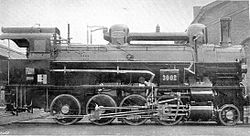The Street railway journal (1900) (14571754959)
Identifier: streetrailwayjo161900newy (find matches)
Title: The Street railway journal
Year: 1884 (1880s)
Authors:
Subjects: Street-railroads Electric railroads Transportation
Publisher: New York : McGraw Pub. Co.
Contributing Library: Smithsonian Libraries
Digitizing Sponsor: Smithsonian Libraries
View Book Page: Book Viewer
About This Book: Catalog Entry
View All Images: All Images From Book
Click here to view book online to see this illustration in context in a browseable online version of this book.
Text Appearing Before Image:
somethingserious, as will be seen from its length and bulk. It is,moreover, equipped with two motors of 225 hp each, ableto exert, it is said, between 500 and 600 hp. With regard to the electric locomotive of theOrleans Railroad, its resemblance to those employed atHoboken, N. J., and in the Baltimore Tunnel, will be atonce noted by every American reader. It is due to theFrench Thomson-Houston Company, a fact which willaccount for its construction on these approved lines. Itmay not be generally known that the Orleans Railroad,which at present has its terminal at the very outskirts ofParis, and has therefore been most inconvenient to reach,has lately pushed its way nearer to the heart of the city andhas erected a magnificent new station on the Quai dOrsay.This prolongation of its track is 2,\ miles in length, whichwill give an idea of the distance to be saved by the greatmajority of those who use the road. Over this stretch oftrack eight electric locomotives are to be used, of the type
Text Appearing After Image:
FRENCH THOMSON-HOUSTON ELECTRIC LOCOMOTIVE,ETC., PARIS-ORLEANS R. R. shown, and they have already been tested for their workin situ. Each locomotive has four driving axles with amotor in each, and weighs about 45 tons. These motorsare of the G. E. 55 type, of 175 hp each. Each locomotiveis easily capable of hauling passenger trains from the oldstation to the new in seven minutes, each train being esti-mated at about 250 tons. It is stated that 150 such trainswill be hauled per day to and fro. The trains will arriveat the outer terminus under steam power, and a change oflocomotive will be effected in two minutes. Current is tobe generated at high tension and then delivered by twosub-stations—one at the Quai dOrsay and the other at theQuai dAusterlitz, where the old depot stands. The localcurrent distribution system comprises a third rail externalto the track and an overhead contact in the tunnel at theentrance to the Quai dOrsay, so that each locomotive isprovided with three sliding-
Note About Images
Relevante Bilder
Relevante Artikel
Liste von Lokomotiven auf der Weltausstellung Paris 1900Die Liste von Lokomotiven auf der Weltausstellung Paris 1900 führt die 68 Dampflokomotiven auf, die an der Ausstellung gezeigt wurden. Die meisten Fahrzeuge waren in der Eisenbahnausstellung im Bois de Vincennes als Teil der Ausstellung über das Sport- und Verkehrswesen zu sehen, einzelne Ausstellungsstücke waren auch an anderen Orten untergebracht. Bei den Schnellzuglokomotiven dominierten Lokomotiven mit der Achsfolge 2’B, auch American genannt, die größtenteils als Zweizylinder- oder Vierzylinder-Verbundlokomotive ausgeführt waren. Viele Lokomotiven wiesen Serve-Siederohre auf, die durch Stegen an der Innenseite eine Verbesserung des Wärmeübergangs ermöglichten, aber nur verwendet werden konnten, wenn bei der Verbrennung nicht zu viel Ruß entstand, der die Siederohre zusetzte. Die Preußische S 4 Nr. 74 war die einzige Lokomotive mit Überhitzer. Der Kesseldruck betrug typischerweise 16 bar. Für kurvenreiche Strecken wurden Mallet-Lokomotiven ausgestellt. Für Niederländisch-Indien, Rumänien und Russland bestimmte Lokomotiven verwendeten Ölfeuerung. .. weiterlesen










































